
Fall and Rise of river saraswati-India most sacred river
Rajasthan was green once
When Saraswati was in full flow down the Himalayas, land of Rajasthan was green, fertile with lust vegetations, beautiful with yawning valleys and clean with cool and amiable environment. In this cool amiable climate with abundant of copious monsoon rivers, Great civilizations with large-scale industries and farming prospered on riverbanks of northwestern India. Research suggests that barely five kilometers from the sources of Ganga and Yamuna, Saraswati flowed from the Yamdhar Glacier of the Himalayas, gushing through the doon valley like a beautiful stream, then marched splendidly through Uttaranchal, Yamunanagar in Haryana and Sirsa, Hanumangarh, Suratgarh and Anupgarh in Rajasthan. Then it flowed through the tri-junction of southwest Rajasthan, border areas of Pakistan, Kutch and finally empting into the Gulf of Cambay in southern Gujarat. River Sutlej known as satdru during the Vedic era was a major tributary of saraswati river, joining it near jakhal and then in hanumangarh and anupgarh. River Yamuna, currently a tributary of holy river Ganga, was another major tributary of river saraswati.
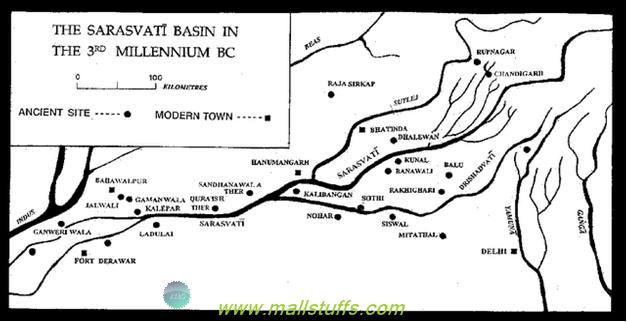
Course of river saraswati
Greenery of rajasthan lost
Later, just before the Mahabharata period, due to earthquake, climatic reason, and tectonic movement between the layers of the earth, saraswati was left with only few small tributaries, finally taking form of a dry valley in deserts of rajasthan. This civilization was so much dependant on saraswati river that post its disappearance, population started migrating to south, east, north and settled on the banks of river Ganges, Godavari, Krishna and kaveri. In these new locations, they pre-dominantly became an agricultural community rather than industrial economy yet they followed their culture of venerating the lost river as their best mother, goddess of wisdom, knowledge and learning. This dependence justifies the rig vedic title ‘ambitame’ honoured to saraswati (Ambitame means best of the mothers).
The green lust vegetations of Rajasthan were lost, replaced by a barren, arid desert where hot winds piles up dunes of sand. Mother earth in its long 4.5 billion years of history has faced many drastic changes leading to complete extinction of several living species. If we compared such events with event of saraswati then you will feel the latter one as a very small scale event though a drastic one which entirely changed the history, livelihood and fortune of the most ancient civilization.

Rajasthan desert
Quest for finding saraswati
All was not lost and after the partition, when detailed excavations were carried out then more than 2500 Harappa type sites were found in states of Punjab, Haryana and Rajasthan, thus proving the Indus-saraswati Civilization to be much bigger than originally thought. Out of these 2500 sites, about one third was found in Pakistani side of the indo-pak border. Some of these important sites are Guneriwala in Pakistan, Ropar in Punjab, Banavali and Rakhigarhi in Haryana, Manda in J &K, Kalibangan in Rajasthan, Alamgirpur near Meerut (UP), Lothal, Dholavira and Surktada in Gujarat and Daimabad in Maharashtra. If we plot these sites on a map then we will find that most of these sites are located on the dry beds of river Ghaggar in Haryana, Punjab and Rajasthan, and Bahawalpur & Sind areas of Pakistan. Incidentally, much of the mapped sites coincides with the sites of Indus river thus giving an apprehension of both being part of the same civilization. River Ghaggar is called as Hakra in Bahawalpur and nara in sindh province of Pakistan.
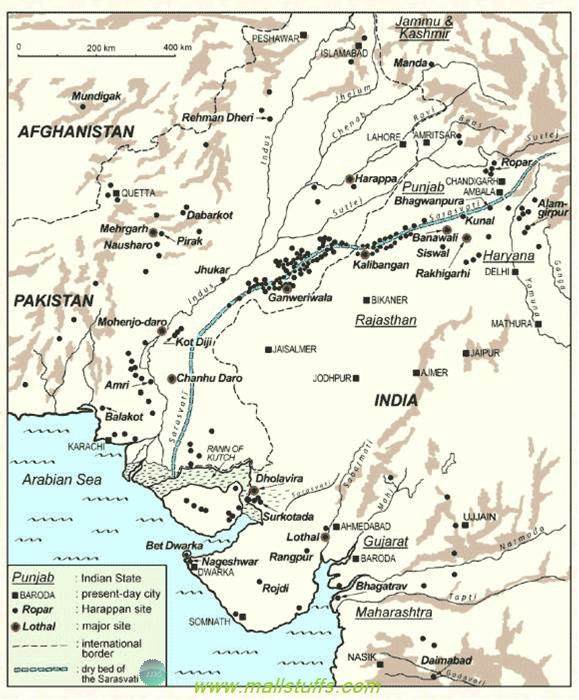
Sites plot across river saraswati
Evidences of highly advanced civilization
Based on the artifacts collected at these sites, it is confirmed that these sites had a well developed democracy in place with citizens involved in professions like agriculture, weaving, pasturing, animal husbandry, pottery, gold mining, diamond carving, farming etc. Indus-Saraswati Civiliation in Harappa, Mohen-jo-daro and Lothal was the earliest civilized urban society with a well-flourished economy based on the concept of trade, democracy and prosperity. Unlike Egyptians and Mesopotamia, There are no evidences of warfare or conquest with other civilizations. “Because of it antiquity and civilization based on the theme of progress and peace, it has attracted global international researcher” says Kalpana Desai, Director at Global Heritage Fund, U.S.A. Citizens of indus-Saraswati civilization were extra-ordinarily innovative, rich in technology, entrepreneurship, drainage & water management, etc and were the only experts in the field of jewelry and cutting precious stones. Owing of such massive infrastructure and trade related activities, many huge ports were built out, one of which was found at lothal with large donut shaped anchors capable of handling titanic like ships.
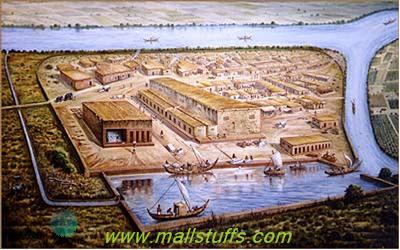
Computer animated model of lothal
Evidence of Town planning, brick structures, drainage system, and water management from these sites is often displayed in various exhibitions held frequently in north India.
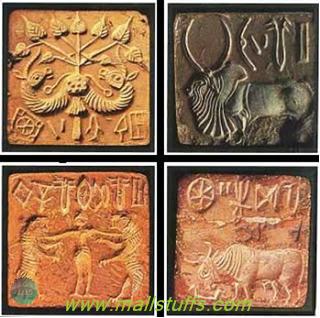
Seals shown in recently held Exhibition
Further, tones of Evidences found at Harappa sites coincide with the description mentioned in the vedic texts, some of which I have described in my previous article.
Combination of archeological evidences and satellite images indicates the saraswati civilization to be spread across one million square kilometers, thus making it the largest ancient civilization of its era.
In avesta (Regions west to india), saraswati was called as Harkhaiti or Haravaiti. The scholars are still debating if the syllable ha was changed to sa by indic Aryans or it was changed otherwise by avestians due to their pronunciation issues (Same like sindhu was pronounced as Hindu thus naming the Indian Vedic religion as Hindu). These questions were based on the myth of Aryan invasion theory which says Vedic Aryans migrating from the west of India.
Government Research confirms the existence of saraswati
The Vedic Sarasvati Nadi Shodh Pratishthaan played a major role in reviving Saraswati River by roping in Indian scientific governmental organization like Indian Space Research Organization (ISRO), Bhabha Atomic Research Centre (BARC) and Regional Remote Sensing Services Centre (RRSSC). Chairman Dr.kasturi and director Dr. J.R. Sharma were very excited and displayed an intense interest in the saraswati river project. RRSSC analyzed satellite images of IRS, thus mapping the entire course of saraswati from the Himalayas to rann of Kutch (Gujarat). On 11 may 1998 right after the pokhran nuclear test blasts, BARC tested water samples of 1000 underground reservoirs within a radius of 200 kilometers of Pokhran. Their findings, also published in Current Science, revealed no nuclear contamination in the tested ground-waters. Normally in a nuclear weapon test, when a hydrogen bomb explodes, huge quantities of tritium are released. Yet, the tested water concluded very small amount of tritium, in compliance with any normal water bodies.
Additionally, BARC announced striking discoveries. First, the tested waters were potable, drinkable, sweet and well suited for cultivation and irrigation; second, the waters matches with the Himalayan glaciers waters; third, they are 9000 to 15000 years old; and finally, the waters were found in the desert areas receiving very scanty rainfall or no rainfall. In short, BARC confirmed ISRO findings of the Saraswati River.
Based on result of vertical electrical sounding technique, ONGC (oil and Ntural gas corporation) with a intention of finding oil in saraswati river, drilled well up to 555 m near jaisalmer (Rajasthan) and drilled water at the rate of 76000 litres per hour, to find very less saline water (3050 milligrams per litres) .
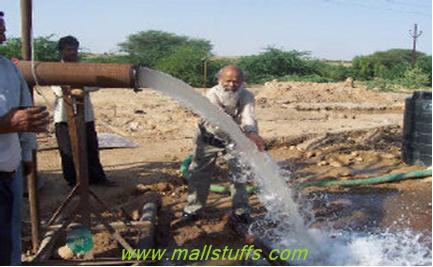
Underground water of river saraswati
Dr. D.K. Chaddha, Chairman of Union Ministry of Water Resources, validated BARC discovery of potable water 30 to 60 meters below the ground, through underground morphological studies.
Over 2,000 archaeological sites were identified by ISRO and ASI on the banks of the Sarasvati. Few of these sites were selected for drilling, with special drilling equipments from Japan, for perfect drilling based on the latitude and longitude data provided by sateliite images. Barring one faulty drilling, all other explorations were successful with discovery of tube wells within a depth of mere 30 to 60 meters.
Remote sensing satellite report
"Recent advancements in space-based sensors and in data processing technologies made it possible", says J. R. Sharma of the Jodhpur-based Remote Sensing Service Centre of the Indian Space Research Organization (ISRO). He and his colleagues, A. K. Gupta and G. Sreenivasan have mapped the "palaeo channels" relics of the river and its tributaries using data from three different sensors on board Indian satellites.
India remote sensor satellites have traced the underground course of Saraswati River, thus kindling hopes of extracting drinking water in the hot arid Thar Desert. Deep in Thar Desert of western Rajasthan, near to highly secure border areas of Pakistan, Giant drilling rigs are used to explore the underground reservoirs to extract drinking water and if successful, it would eliminate the harsh water shortages faced by thousands of locals.
Dr Jagdish Sharma, head of Remote Sensing Services Centre mapped the satellite images and concluded that a major earthquake or a big tectonic activity shifted the course of many tributaries of river saraswati, thereby leading to its gradual demise.
Across the dry river beds of Saraswati River, archaeologists have found tones of artifacts, seals of Bronze Age people, who resided on the banks of the mighty river Saraswati. Archaeologists discovered that their occupation included farmers, priests, merchants, artists, craftsmen etc. Seals with Sanskrit inscriptions have been found thus indicating that the civilization was highly literate and used Sanskrit as their language of communication and trade.
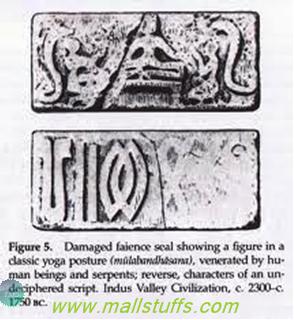
Seals with Trident, Bull and Peepal motifs
Due to lack of knowledge on values of cultural heritage, many archaeological artifacts from these cultural sites are often smuggled out by illiterate locals.
To those refuting the present ghaggar-hakra river as river saraswati without any satisfactory explanations, Professor Bisht and Lal of ASI raised the questions of “why so many sites- such as Gaveriwala, Rakhigarhi, and Dholavira were found on the dry beds of river ghaggar -if it had not been a perennial river”.
They also asked everone to read the brilliant work, ‘Sarasvati: The River That Disappeared’, by eminent Himalayan ecologist, Professor KS Valdiya, This book contains many scientific explanation to take you on a journey to rejuvenate the ancient past of Sarasvati river basin.
More evidences
In May 2004, high-grade metamorphic rocks belonging to paleo-glaciated regions of Central Himalayas were excavated by ASI. At Nausharo in Pakistan, two female figurines with golden-yellow ornaments, black hair, sindoor on forehead were unearthed. Shivling were found at Harappa and terracotta models in Kalibangan.
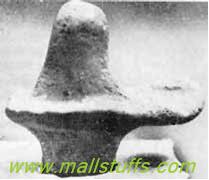
Shivling of Kalibangan
Sankha bangle dated 6500 BC was found at Nausharo. Even today, Industry of sankha bangles has a turnover of 10 million dollars in west Bengal alone. Use of sankha bangles is a must in Bengali marriage and these sankha bangles are often shown in images of lord Vishnu and lord Krishna.
Further some artifacts are found in Indus script which dr.kalyanaraman claims to be a mleccha language (same language used by Yudhishthira and Vidura in Mahabharata to discuss about laaksha griha (Wax house)). This confirms sanskrit and other Indian languages to be proto-vedic and not indo-european languages.
In 2003-2004, Archaeologists found three sites and a Buddha vihara in Adi Badri alone. Himalyan glacier expert, Dr. Vijay Mohan Puri, reported metamorphic rocks on the terraces of River Sarasvati, thus proving Adi Badri as the site of Saraswati River from its source ‘Himalayan Mountains’. Adi Badri is a town located 70 kms from Dehradun & kurukshetra each and 20 kms from Jagadhri (Yamuna Nagar). Dr. Puri further traced the origins of Sarasvati at Rupin-Supin glaciers north of kurukshetra, where plate tectonic movements caused a lateral shift of Shivalik ranges, thus causing Yamuna, a major tributary of saraswati, to migrate eastwards to join Ganga at Prayag (Allahabad), thereby forming the Triveni Sangam. Thus, River Sarasvati flowed from the Svargarohini glacier mountain and today, the revived saarswati river has reached up to Barmer, Rajasthan, and would reach the Rann of Kutch in next few years.
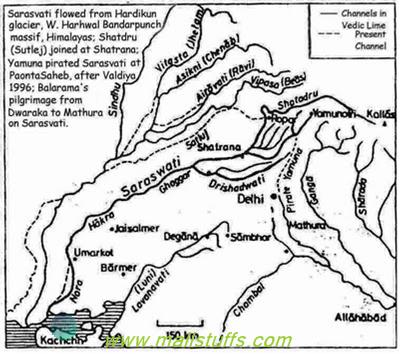
Course of river saraswati
Dr. S. Kalynaraman took premature retirement from his employer Asian Development Bank to start his research on Saraswati River at sarasvati-Sindhu Research Center in Chennai. In this research center, he has kept his 200 page well compiled monogram on Sarasvati related research. This book can be downloaded from the site. In this book, you will find the entire history of river system in northern india along the course of river saraswati, Ganga and its tributaries. Amazed by his detailed work, many north Indian state governments stepped in to start various excavation projects along the course of river saraswati with a hope of obtaining more evidences. This abundance of evidences paved the way to push back the Indian civilization by at least two millennia. What even more exciting about this research is that even Pakistani historians and archaeologist are co-operating in digging out more and more evidences along the course of vedic river saraswati.
13 kms from Kurukshetra is the historic village of Bhoresaidan. Yes, it is the same village named after the kaurava great warrior Bhurisrava, who died fighting against pandavas in Mahabharata. A dusty kachha road through this village leads to a beautiful valley, covered with rocks and soil with various sedimentary deposits. Scooping up some soil of this valley, Rajesh Purohit, said emotionally "This soil has a lot of history. After all, rivers Sarasvati use to flow through here."
On 5th may 2001, Times of India wrote an article presenting various facts and figures of the ongoing research on Saraswati River over the past 15 years.
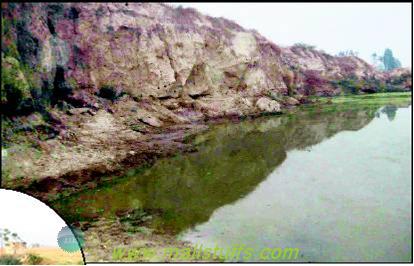
View of Bhoresaidan
French historian, Michel Danino ,Who was very interested in Indian philosophy researched Indian history and wrote numerous book on Indian literature and history. Based on his scientific research on river saraswati, he wrote a remarkably well and highly popular acclaimed book - The Lost River
Saraswati river flowing underground
Any river has several sources associated with it with the major one being surface water. Currently, Ghaggar River has surface flow only during monsoons. Generally, River channels are embedded with thousand feet of sediments and sand deposits. Beneath this sand deposites or even below surface bed rocks, water flow underground which is the case with river ghaggar. At some places, this underground water comes to the surface as springs and some being hot springs, cures several skin related diseases. In India, near to such hot springs, temples are constructed where the devotees prays with the intent of curing their diseases, after taking bath in the Hot springs. Many such springs exists on the route of river Ghaggar (Ex. Kapil muni in Haryana) which is taken as evidence of river flowing underground. Theoretically, Groundwater flow varies depending on hydraulic gradient and permeability of the aquifer, generally averaging around 10 meters per day. This average matches with the Ghaggar River; where the ground water flows out as a spring at better than average rate.
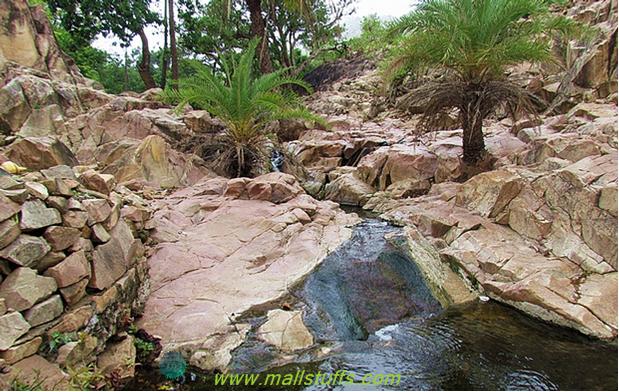
One of such hot spring in Gujarat
Groundwater of rajasthan desert areas is rich in stable isotope content comparable with waters of Himalayan Rivers. Radiocarbon testing suggests the level of carbon-14 isotope decreasing along the downstream route indicating indicating hydraulic continuity of the undergound Saraswati channel from Kuria Beri to Ghantiyalji.
Government efforts to revive saraswati river
Former President A.P.J. Abdul Kalam expressed his interest in reviving the lost heritage of India and in transforming lives of people staying along the western deserts of Rajasthan. He also asked experts to showcase a presentation on various archaeological artifacts excavated along the saraswati route as well as satellite images. Later in April 2004, President Abdul Kalam visited an exhibition on Saraswati River and said the following words at the end of the exhibition “Delighted to see the hard work in realizing the reality of epic information.”
Tube wells are dugged out at Kapalmochan and Ranmochan, which lies on dry beds of river saraswati. According to Mahabharata, at these two places, Pandavas warrior took bath in Saraswati River. Terming these places as sacred, local offers their prayers and takes faithful baths from the water tugged out through tube wells. Today, it has become a well known pilgrim spot, thanks to the efforts of the local government. Every year, on Karthik Purnima, millions of pilgrims offer their prayers after taking a sacred dip in waters of river saraswati.
There is an ongoing project of constructing a 200 km channel for bringing the waters from mansarovar to Sabarmati, Ahmadabad, by joining river sharda through an aqueduct across the Yamuna.
Gujarat government recently announced setting up a world class museum showcasing all collected coins, seals, artifacts and other archaeological remains excavated from Indus-saraswati civilization.
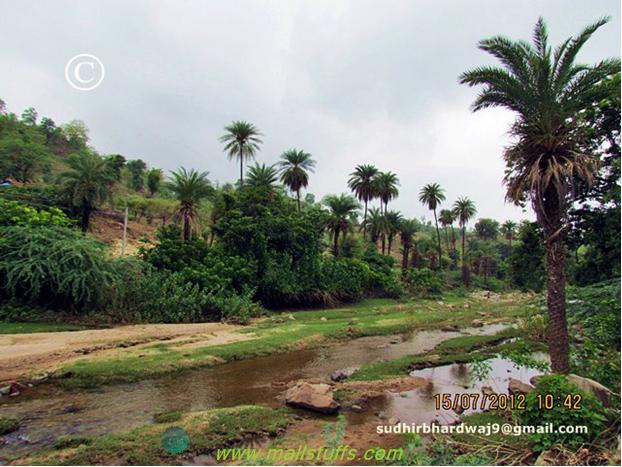
Revived saraswati river of Gujarat
Many canals in north India built for the purpose of irrigation is built along the course of river saraswati. Satellite images show small streams flowing underground in this basin which most probably could be the remaining waters of the Saraswati River. No doubt the Nal Sarovar, spread over an area of 123 sq.km, is a popular tourist attraction for its thousands of unique, magnificent birds, pools, variety of water plants and rushes, is formed by sweet water of Saraswati. Many migratory birds are attracted to the swamps and forests of nal sarovar. In 2001 Gujarat earthquake, sweet water gushed out of Rann of kutch which is very surprising because of its salt and sea water.
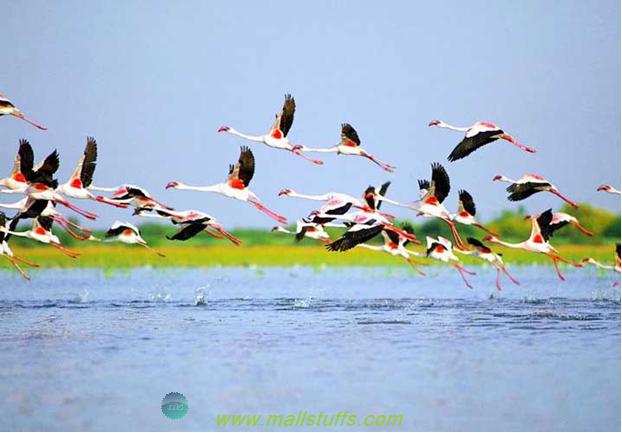
Migratory birds (Flamingoes) at nal sarovar
On lab testing, this water was found to be at least 5000 years old. Being an area close to the sea with no rivers nearby, traces of sweet water raises the question of some river flowing underground, which could be the lost waters of river saraswati. India is endowed with the largest water-bearing monsoon clouds in the world and as per the estimate, Indian monsoon clouds is as large as the entire Europe continent and so big enough to feed innumerable rivers and its tributaries in the northern plains of India.
The real purpose of various government programmes was to address the "plaguing problem" of the origin of the Aryans, and also to refute the western theory of Aryan invasion.
In Haryana, many water harvesting projects have started at Adh Badri, Bilaspur, Kapala Mochan up to Pehoa, an overall distance of 150 km. These projects are aimed at cleaning water, clearing the path of river, restoring and renewing the ghats of river saraswati. Haryana government assured its citizens of making Kurukshetra not only a world class tourism destination but also a pace-setter for ‘Rejuvenating Saraswati’ revolution.

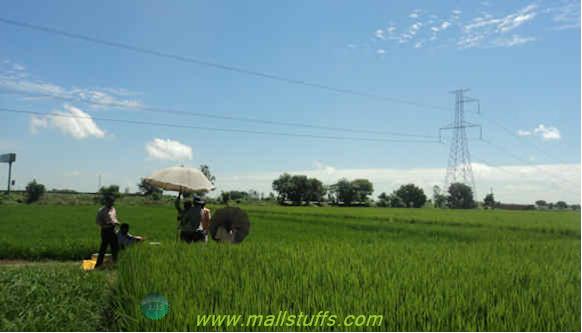
Fields of kurukshtera using waters of revived saraswati river
Work has started to extend the Rajasthan Canal, now known as Sarasvati Mahanadirupanahar, from Danan in Jaisalmer district to Gedra Road in Barmer district of Rajsthan. Further, waters of Sutlej River, tributary of Sarasvati, would be diverted to take its water to Rann of Kutch of Gujarat, through Mahanadirupanahar.
Using a detailed monograph, Dr. K.R. Srinivasan explains his plans of digging 10 lakhs huge wells in Rajasthan alone along the path of saraswati river basin, a project already started by Rajasthan government. For this, there is a need to discharge surface water through Rajasthan canal, which is extended till Gujarat. In return, Gujarat share waters of river narmada with Rajasthan. Punjab also releases water of sutlej Yamuna link into the Sarasvati Mahanadi Roopa Nahar to save their dams located at fault-lines adjoining the Sutlej-Beas river basin, on account of ongoing tectonic plates movements. Thus, waters have started flowing in the 50 feet wide, 15 feet deep Sarasvati nahar, causing the dunes of sand to disappear as the banks of river saraswati are slowly reborn into green forest. Already 15 lakh acres of land has been brought under cultivation.
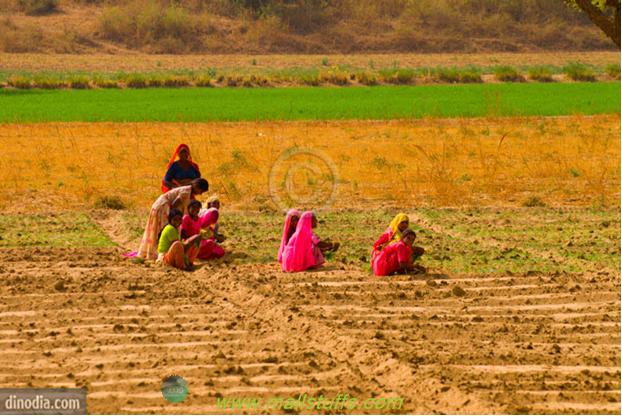
Deserts of jaisalmar brought under cultivation
Conclusion
Since two ruined cities ‘Harappa’ and ‘mohen-jo-daro’ were found on the banks of river Indus and its major tributaries with no signs of saraswati river, this civilization was apparently named as Indus Valley Civilization by sir john marshal. Now that over 2,000 of the 2,600 sites are found to be on the river Sarasvati, the civilisation should be called the Sarasvati civilization or Indus-saraswati civilization.
Saraswati was revered not merely for its sanctity but also for being the mother of the ancient civilization. I salute and chant hyms of Goddess saraswati for being the cradle of vedic literature and for nurturing the highly advanced Vedic civilization on its highly fertile banks.

Jai Mata Di!!!Jai Mata Di!!!!
Note: Images used on this website
are either a production of Bhaktivedanta Book Trust(https://www.krishna.com), Iskcon
Foundation or were found in google search under "Free to use and share". If any
of the images presented here violates copyright issues or infringes anyone copyright
or are not under "Fair use", then please bring it to our notice. Read
Disclaimer for more.
Share this to your friends. One of your friend is
waiting for your share.
Related Articles
Is god female-Yes or No
Science in Hinduism-Motion of earth around sun
How Saraswati- india most sacred river disappeared
Vedas Quotes Against Present Caste System
Do plants sing or create music
Science in Hinduism-Theory of perception
Fall and Rise of river saraswati-India most sacred river
Science in hinduism-Evolution in vishnu avatars
Is Goddess Durga the supreme universal mother
Science in hinduism-Extraction-Contraction and creation of universe
Post Comment